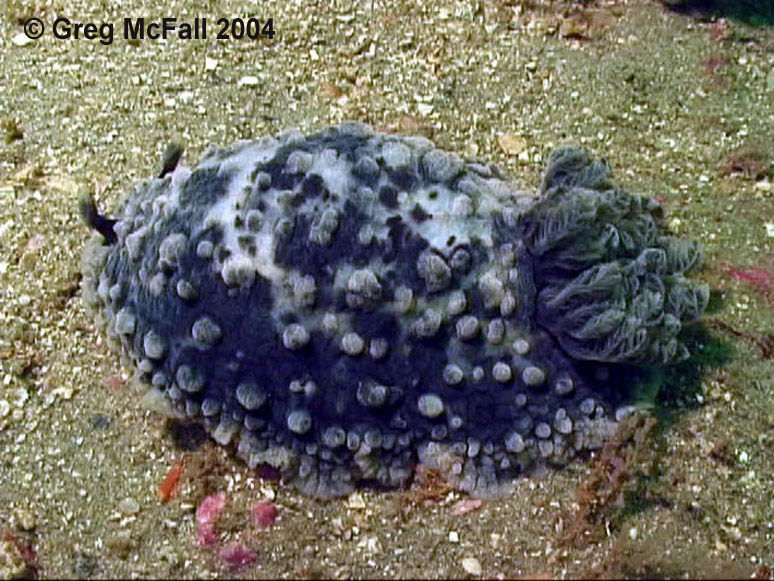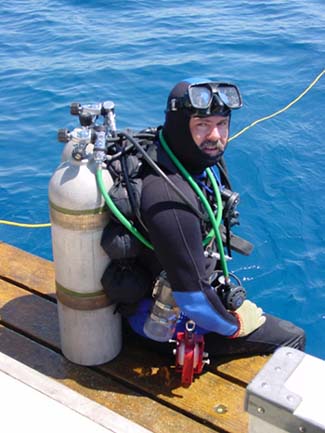 |
Dendrodoris warta
Photo couresty of Greg McFall
Dendrodoris warta Marcus & Gallagher, 1976
Well this weeks BOW comes from a group of researchers on the eastern seaboard of the US. Darn I didn't even think they had Branchs there. That's why this one stumped me right off the bat. Nevertheless, buddies Angel Valdes and Terry Gosliner came to the rescue and had this interesting critters name right on the tip of their tongues.
Greg McFall, in association with Alan Harvey, Danny Gleason and Steve Vives at Georgia Southern University, is producing a web-based invertebrate identification guide for Gray's Reef National Marine Sanctuary , off the coast of Georgia. Greg caught this specimen on video last summer. I knew the species was a member of the genus Dendrodoris due to its ruffled margin of the mantle . At first I thought it might be a warty version of Dendrodoris krebsii (Bill Rudman's Sea Slug Forum) who shows a great deal of color variation on the mantle. Terry and Angel quickly pointed out that this was a Marcus and Gallagher species described from Florida.
Greg's specimens certainly match the original description the species having a dark brown to black background with tan to pinkish-beige variably sized tubercles and margin of the mantle. The rhinophores have light colored lamellae and tips. Greg even caught a shot of the egg ribbon which in this case varies from Marcus and Gallagher's original color description of a ruffled orange spiral. Greg reports that while this critter is not the most common on the reef, it is pretty conspicuous as it grows to roughly the size of a baseball.
The species name "warta" is certainly appropriate in this instance, as most species of Dendrodoris have smooth mantles, not the tall tubercles seen here. The wartiest of all Dendrodoris , however, is the gigantic, Dendrodoris carbunculosa from the tropical Pacific. The tubercles on the mantle of D. carbunculosa are huge and compound.
We look forward to the Georgia Southern's web site to see other opisthobranch species from this region, as sorely needed scientific resource.
Reference:
Marcus, Eveline du Raymond & Gallagher, S.B. 1976. A new species of Dendrodoris from Florida. The Veliger, 18(4): 353-356.
Danville, Calif
Jan 2004
Greg McFall

Gray's Reef contains one of the largest near-shore, live-bottom reefs off the Southeastern United States, encompassing approximately 17 square nautical miles. The sanctuary supports an abundant reef fish and diverse invertebrate community. Gray's Reef was designated in 1981 as the nation's fourth marine sanctuary. Five years later, its value as a unique bioregion was recognized by the United Nations through proclamation as an "International Biosphere Reserve." The South Atlantic Fisheries Management Council has also designated the Sanctuary as a Habitat of Particular Concern (HAPC). Because it is representative of hard bottom ecosystems, which occur throughout the South Atlantic Bight, it is a popular area of scientific interest and is an area of great favor to sport fisherman and divers alike. For more information on Gray's Reef, visit their website at: www.graysreef.nos.noaa.gov NOAA National Marine Sanctuary Program (NMSP) seeks to increase the public awareness of America's maritime heritage by conducting scientific research, monitoring, exploration and educational programs. Today, 13 national marine sanctuaries encompass more than 18,000 square miles of America's ocean and Great Lakes natural and cultural resources. NOAA's National Ocean Service manages the NMSP and is dedicated to exploring, understanding, conserving and restoring the nation's coasts and oceans. The National Ocean Service balances environmental protection with economic prosperity in fulfilling its mission of promoting safe navigation, supporting coastal communities, sustaining coastal habitats and mitigating coastal hazards. Send Greg mail at Greg.McFall@noaa.gov |
WEBMASTER ' S NOTES: I was absolutely amazed at the sharpness of the video stills that Greg sent to us. In this regard I asked Greg to give Slug Site readers an insight as how this was accomplished:
"...Tips for capturing still images from video:
To start off with, It helps to have a good quality camera and a decent video light. These video images were recorded with a Sony model DCR-TRV900, 3CCD (three color correcting diode) camera which records on the Mini-DV (digital) tape format. The camera was contained in an Ikelite underwater housing and a single video light, also manufactured by Ikelite, was used to light the subject.
When taping a particular subject from which still shots will be obtained, the quality of the resultant image is dependant on how well your subject was lit and how steadily the camera was held. Most consumer-end digital cameras operate on a recording system called "progressive scanning." With progressive scan technology, an image sensor gathers its data and processes each scan line one after another in sequence from the top of the screen to the bottom. When the camera (or subject) is moved between "scans", edges in your image often will appear pixelated or jagged. For this reason, it is critical to hold the camera as still as possible while shooting a subject from which you'd like to obtain still shots.
Better yet, the newest technology to hit the streets is a recording format called 24p. Instead of "scanning" the image that is being recorded, the camera essentially takes 24 still images per second to capture movement in a more "fluid" manner. Twenty-four frames per second is the same "frame rate" that has been used to make movies, the major difference here is that the images are recorded digitally instead of being captured on film. Consequently, the image quality of "captured" images from this recording format are of even higher quality than images captured from a progressive scan recording. Currently, the only camera on the market that uses this technology is the Panasonic AG-DVX100 which pushes the price barrier of "consumer" electronics.
If the subject being taped is not well lit, the camera will have trouble focusing and exposing the shot properly. One major difference between "still" cameras and the images you get from video is that a video light will not "stop" action like the flash from a strobe and any fast movement within the frame will appear as a blur; this is the major disadvantage to shooting video and capturing images from tape.
Most digital video cameras (and underwater housings) have a "photo" button which either allows for still recording of an image directly onto the tape, or saves the image to a "memory stick" which can be downloaded to your computer. If the camera does not support this media, there are digital playback decks (e.g. Sony GV-D1000 Mini-DV) that support "memory stick" recording. To record an image during tape playback is as simple as pushing the "photo" button on the deck whenever you see an image you like. Downloading the images is accomplished by transferring the memory stick to a reader which is attached to the computer. Once the image is in the computer, you can adjust attributes of the image such as contrast, color and image sharpness using a variety of software programs (e.g. Adobe Photoshop.)..."
Greg's photos came in the standard video 640 x 480 format. I was able to use a little known quirk of Photoshop that allows incremental resizing of images with minimal distortion. Just click Image Size and use PERCENT. Type in 110 and resample. Repeat for desired image size in 10 % increments. You'll be amazed!!
Jan. 2004
Taxonomic information courtesy of:

David W. Behrens
Author:
Pacific Coast Nudibranchs
Send Dave mail at dave@seachallengers.com
|
